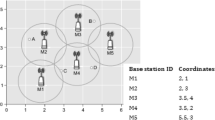Abstract
Major advances in the fields of Internet and Communication Technology (ICT), data modeling/processing, and sensing technology have rendered traditional environments (e.g., cities, buildings) more connected. Although the sensed data could be useful for various applications (e.g., event detection in cities, energy management in commercial buildings), it first requires pre-processing to clean various inconsistencies (e.g., anomalies, redundancies, missing values). In this work, we focus on managing data redundancies in connected environments. Existing approaches suffer from (i) disregarding edge data redundancies either at the edge or at the core of the network; (ii) disregarding sensor mobility and the dynamicity of the network; (iii) disregarding the limited resources of edge devices; (iv) disregarding network/infrastructure resources; and (v) disregarding data consumer needs/requirements when cleaning the data redundancies. To address these limitations, we propose here DRMF: Data Redundancy Management for leaF-edges allowing to identify and remove data redundancies in connected environments at the device level. DRMF considers both static and mobile edge devices, and provides two algorithms for temporal and spatio-temporal redundancy detection. Once redundancies are identified, DRMF performs data deduplication taking into account the dynamic requirements of data consumers and device resources (e.g., processing, battery, memory). Experimental results highlight the performance and accuracy of our solution in detecting and eliminating edge data redundancies.





Similar content being viewed by others
References
Alam M, Abd Aziz A, Latif S, Awang A (2019) Data clustering technique for in-network data reduction in wireless sensor network. In: 2019 IEEE student conference on research and development (SCOReD), pp 317–322. IEEE
Alam M, Aziz AA, Latif S, Awang A (2020) Error-aware data clustering for in-network data reduction in wireless sensor networks. Sensors 20(4):1011
Baba AI, Lu H, Xie X, Pedersen TB (2013) Spatiotemporal data cleansing for indoor rfid tracking data. In: 2013 IEEE 14th international conference on mobile data management, vol 1, pp 187–196. IEEE
Bailey J, Papamarkos G, Poulovassilis A, Wood PT (2004) An event-condition-action language for xml. In: Web dynamics, pp 223–248. Springer
Boley H, Tabet S, Wagner G (2001) Design rationale for ruleml: a markup language for semantic web rules. SWWS 1:381–401
Chowdhury S, Benslimane A (2018) Relocating redundant sensors in randomly deployed wireless sensor networks. In: 2018 IEEE global communications conference (GLOBECOM), pp 1–6. IEEE
Fang X, Misra S, Xue G, Yang D (2011) Smart grid-the new and improved power grid: a survey. IEEE Commun Surv Tutor 14(4):944–980
Gubbi J, Buyya R, Marusic S, Palaniswami M (2013) Internet of things (iot): a vision, architectural elements, and future directions. Future Gener Comput Syst 29(7):1645–1660
Harb H, Makhoul A, Abou Jaoude C (2018) En-route data filtering technique for maximizing wireless sensor network lifetime. In: 2018 14th international wireless communications and mobile computing conference (IWCMC), pp 298–303. IEEE
He Q, Li Z, Zhang X (2010) Data deduplication techniques. In: 2010 international conference on future information technology and management engineering, vol 1, pp 430–433. IEEE
Horrocks I et al (2004) Swrl: a semantic web rule language combining owl and ruleml. W3C Member submission 21(79):1–31
Idrees AK, Al-Yaseen WL, Abou Taam M, Zahwe O (2018) Distributed data aggregation based modified k-means technique for energy conservation in periodic wireless sensor networks. In: 2018 IEEE Middle East and North Africa communications conference (MENACOMM), pp 1–6. IEEE
Ismael WM, Gao M, Al-Shargabi AA, Zahary A (2019) An in-networking double-layered data reduction for internet of things (iot). Sensors 19(4):795
Ismael WM, Gao M, Yemeni Z (2021) Esrra-iot: Edge-based spatial redundancy reduction approach for internet of things. Internet of Things 14:100388
Li S, et al (2019) Ef-dedup: Enabling collaborative data deduplication at the network edge. In: 2019 IEEE 39th international conference on distributed computing systems (ICDCS), pp 986–996. IEEE
Mansour E, et al (2020) Data redundancy management in connected environments. In: Proceedings of the 16th ACM symposium on QoS and security for wireless and mobile networks, Q2SWinet ’20, pp 75–80. Association for Computing Machinery, New York, NY, USA. https://doi.org/10.1145/3416013.3426451
Marinakis V, Doukas H (2018) An advanced iot-based system for intelligent energy management in buildings. Sensors 18(2):610
Paschke A (2006) Eca-ruleml: An approach combining eca rules with temporal interval-based kr event/action logics and transactional update logics. arXiv preprint cs/0610167
Patil P, Kulkarni U (2013) Svm based data redundancy elimination for data aggregation in wireless sensor networks. In: 2013 international conference on advances in computing, communications and informatics (ICACCI), pp 1309–1316. IEEE
Suma S, Mehmood R, Albeshri A (2017) Automatic event detection in smart cities using big data analytics. In: International conference on smart cities, infrastructure, technologies and applications, pp 111–122. Springer
Ullah A, Sehr I, Akbar M, Ning H (2018) Fog assisted secure de-duplicated data dissemination in smart healthcare iot. In: 2018 IEEE international conference on smart internet of things (SmartIoT), pp 166–171. IEEE
Ullah A, et al (2019) Secure healthcare data aggregation and deduplication scheme for fog-orineted iot. In: 2019 IEEE international conference on smart internet of things (SmartIoT), pp 314–319. IEEE
Author information
Authors and Affiliations
Corresponding author
Additional information
Publisher's Note
Springer Nature remains neutral with regard to jurisdictional claims in published maps and institutional affiliations.
Rights and permissions
About this article
Cite this article
Mansour, E., Shahzad, F., Tekli, J. et al. Data redundancy management for leaf-edges in connected environments. Computing 104, 1565–1588 (2022). https://doi.org/10.1007/s00607-021-01051-4
Received:
Accepted:
Published:
Issue Date:
DOI: https://doi.org/10.1007/s00607-021-01051-4




